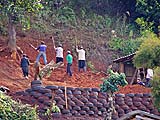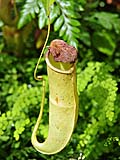Mae Sa Valley (January 8, 2010)
The temperature was perfect. In 2008, I was freezing our first night here, but perhaps due to the rain, the overnight weather was quite mild, and inside number 39, the clock-thermometer did not dip below 70 degrees.
For breakfast, we returned to our long dinner table, which now had a view of the pleasant grounds. Thin rice vermicelli were stir-fried with Chinese broccoli and a little chicken. The flavor improved considerably with the administration of some chilli-infused vinegar and powdered dried chillies from the communal bowls. Fruit platters followed the noodles. This was fairly light by our standards, but we would be eating again shortly, so it was not wise to stuff ourselves.
We urged our vans up the steep road to Mae Sa Mai, a village of Hmong (Mon in Thai) who settled here over a hundred years ago. The “hill tribes” of Hmong, Karen, and Lisu peoples maintain many traditional customs, including everything from language and handicrafts to religious beliefs and tribal laws. The low position of these migrants in Thai society makes them vulnerable to discrimination and exploitation, but this obviously is not unique to Thailand.
For many years, Kasma has come to visit Ying and his daughters, who are Kasma’s goddaughters. Ying received us into his home for a traditional New Year’s ceremony in which a shaman ties a spirit string around the wrist, and then administers a shot of delicious smelling but unexpectedly fierce tasting home-brewed lychee spirit. We then ate our fill from bottomless bowls of homemade chicken soup and eventually went “shopping” in front of the nearby homes for traditional Hmong clothing, and tourist goods they sell to people who have difficulty imagining a use for brightly colored ceremonial clothing.
Wandering around the village, we encountered chickens, roosters, and little chicks (free range is not a marketing slogan here); women doing needlework; pigs in their pens; and dogs lying in the sun. We also saw quite a few kids playing — this is children’s day in Thailand, so school was not in session — and one young boy cooking something in a wok over an outdoor fire. We returned to Ying’s house for a box lunch of basil chicken over rice (from the resort) and more chicken soup.
After departing the village, some of us we headed over to nearby Queen Sirikit Botanic Gardens where we strolled through the hothouse exhibits photographing anything that looked interesting. While the tropical rainforest hothouse was closed for renovations, there were such extensive collections of orchids, bromeliads, and other plants that it would have been overload. We combed through the gift shop on the way out and headed back to the resort.
I checked in at the Health Centre for my traditional Thai massage and was directed to a locker room to change into some baggy pants that tie at the wait, and a comfortable pajama-like shirt. Massages here are conducted on four outdoor platforms, and judging by the sounds in the garden, I seemed to be suffering the most. Turns out one hour cost $19 with tip, about three times the cost back in Bangkok, but not bad by resort standards.
There was little time to relax, as we had to “rehearse” for tonight’s performance. Around a table by the pool, we discussed songs and dances, and generally coped with the challenge as best we could. Time to change into our evening wear. I had purchased a pair of Hmong pants in the village. The shiny black velour fabric was decorated at the hemline with needlepoint patterns and the sides of the legs were demarcated with colorful circular patches. (The central part of the pants was very baggy, leading to thoughts of MC Hammer’s outfit in the video for “U Can’t Touch This,” but we decided not to go there.) Although it was not an aesthetic match, I put on one of my batik shirts from Krabi, packed up my laptop, and headed out.
Dinner was served on one of the wider terraces in the garden, as the sun had been sufficiently strong during the day to dry the ground a bit. We were seated on straw mats on both sides of a low table. We helped ourselves to numerous dishes from a buffet, the tastiest of which probably were the masaman curry beef, deep fried fish in a spicy-sweet sauce, and the fermented shrimp “dip” served with the typical raw vegetables. (The eggplant salad, topped with sliced boiled eggs, had a bit of a fishy flavor and lacked any contrasting crunchy textures. The fern-like green vegetable had been sitting for a while, so the sauce had drained to the bottom of the pan rendering the flavor was a bit weak and indistinct. The stir-fry of chicken, onion, red and green chillies, and tree ears felt like a re-run.) The perfectly crunchy deep fried bananas, served atop a warm caramel-like glaze, redeemed the meal. We were ready for the entertainment phase.
While we had been eating, Kasma’s guests from the Hmong village had been at a table on the other side of the bonfire. First up were a young boy and his uncle demonstrating the gam, a set of traditional Hmong pipes. The tune — tones held for long intervals — was unfamiliar, as was the sequence of steps, postures, and rotations as the musicians performed. It would be interesting to learn more about what this signifies. But no time for that: six Hmong girls promptly divided themselves into two lines and performed a traditional dance with a lot of hand gestures. Eventually, the recorded music finished and they lined up just in front of our straw mat and sang us a song. We reciprocated with “Home on the Range.” Then they sang another song, and we replied with “I’ve Been Working on the Railroad.” And so the pattern continued.
Our next song was YMCA, but I hadn’t woken up the PC, so as Windows came back to life, we taught them the Chicken Dance. Half of us had just learned the dance this afternoon, so it was pretty easy to learn. Then the Hmong girls then taught us their Chicken Dance. I fired up PowerPoint for the lyrics to “YMCA.” As we sang and spelled out the letters, our guests seemed puzzled by the arm motions. I’m guessing it doesn’t translate very well because the Thai alphabet is completely different than ours; making script characters with your arms probably wouldn’t have occurred to them. After another charming number from their side, we switched on iTunes and played “My Girl” which we sang as “Mae Sa” (the area in which we are staying). Based on our earlier 5-minute rehearsal, we did our best imitation of Motown singing groups with (mostly? somewhat?) coordinated steps and arm motions. Unfortunately, no one among us could really see everything that was going on, so we don’t know whether their slightly dazed expressions indicated awe or pity.
After their next song, we had to admit that we didn’t have any more on our list. Our rousing rendition of “What do you do with a drunken sailor” would be our closing number. We then had the traditional posing for pictures, first groups and then mismatched portraits. Our tallest traveler, towering over two Thai children half his height, proved to be the most popular subject.
After our guests had departed for their village, we went over the itinerary for the next couple of days: a lot of driving tomorrow, then four nights in another beautiful resort, elephant rides, remote mountain villages, and maybe even some R&R.






















Sorry, the comment form is closed at this time.